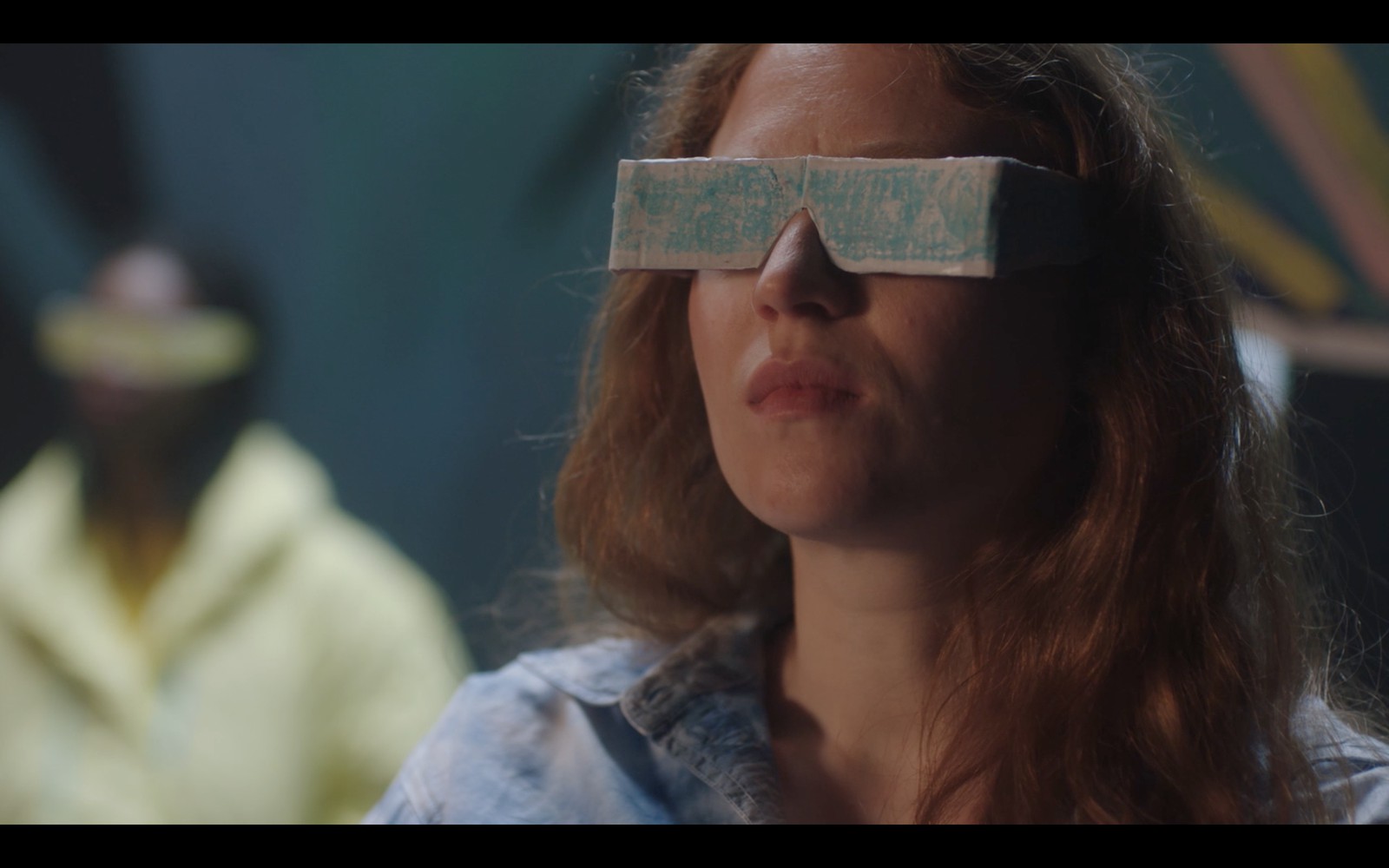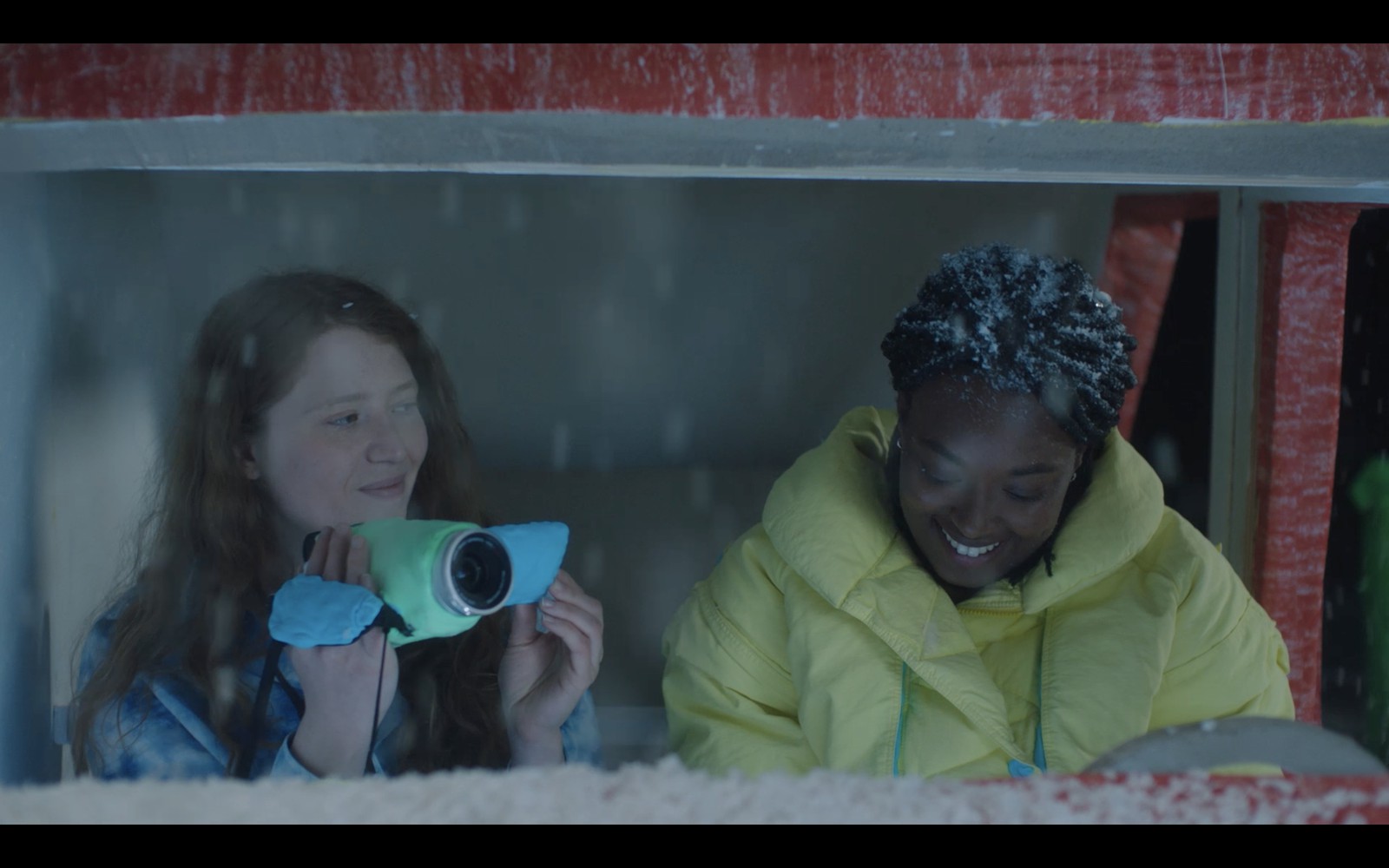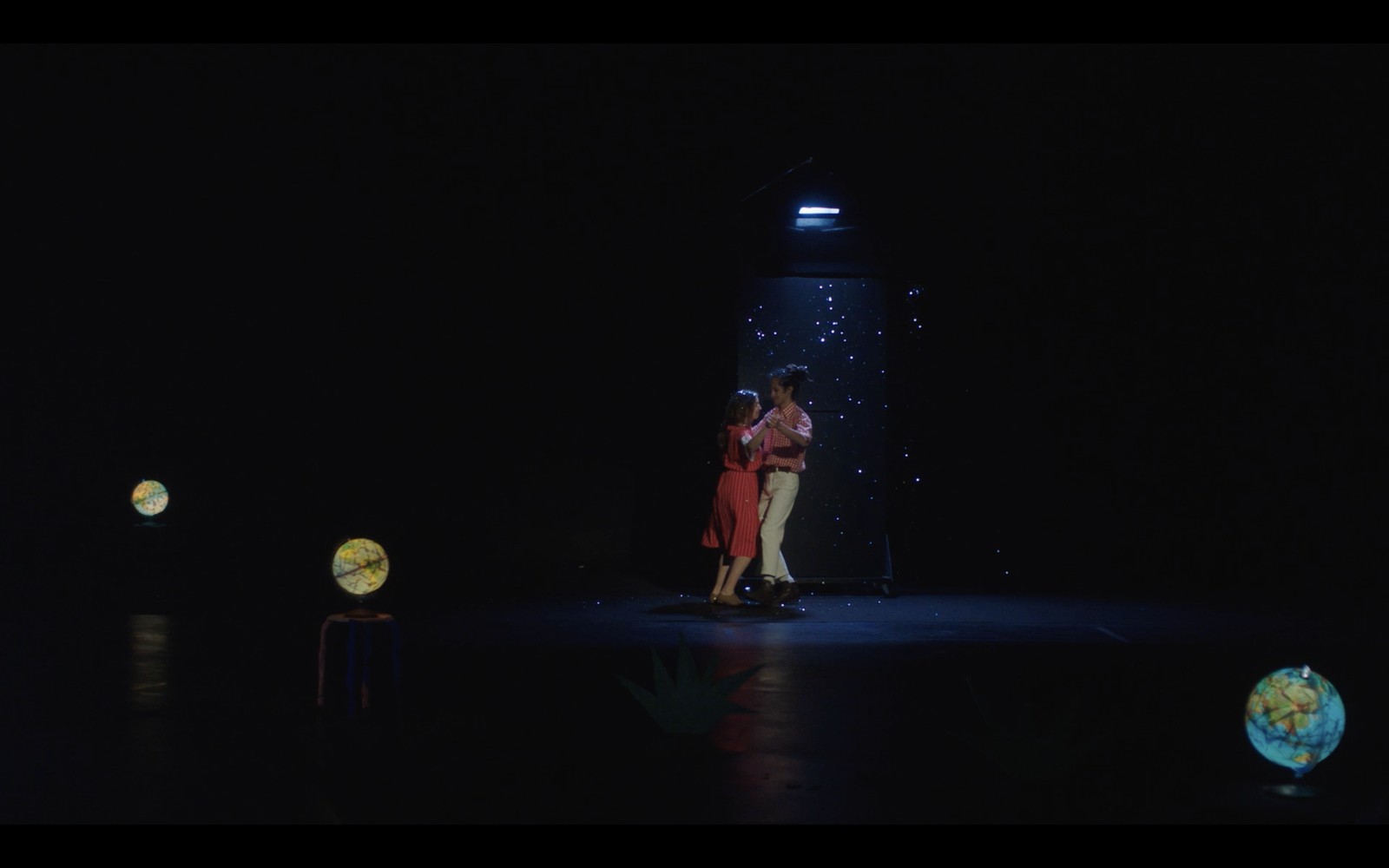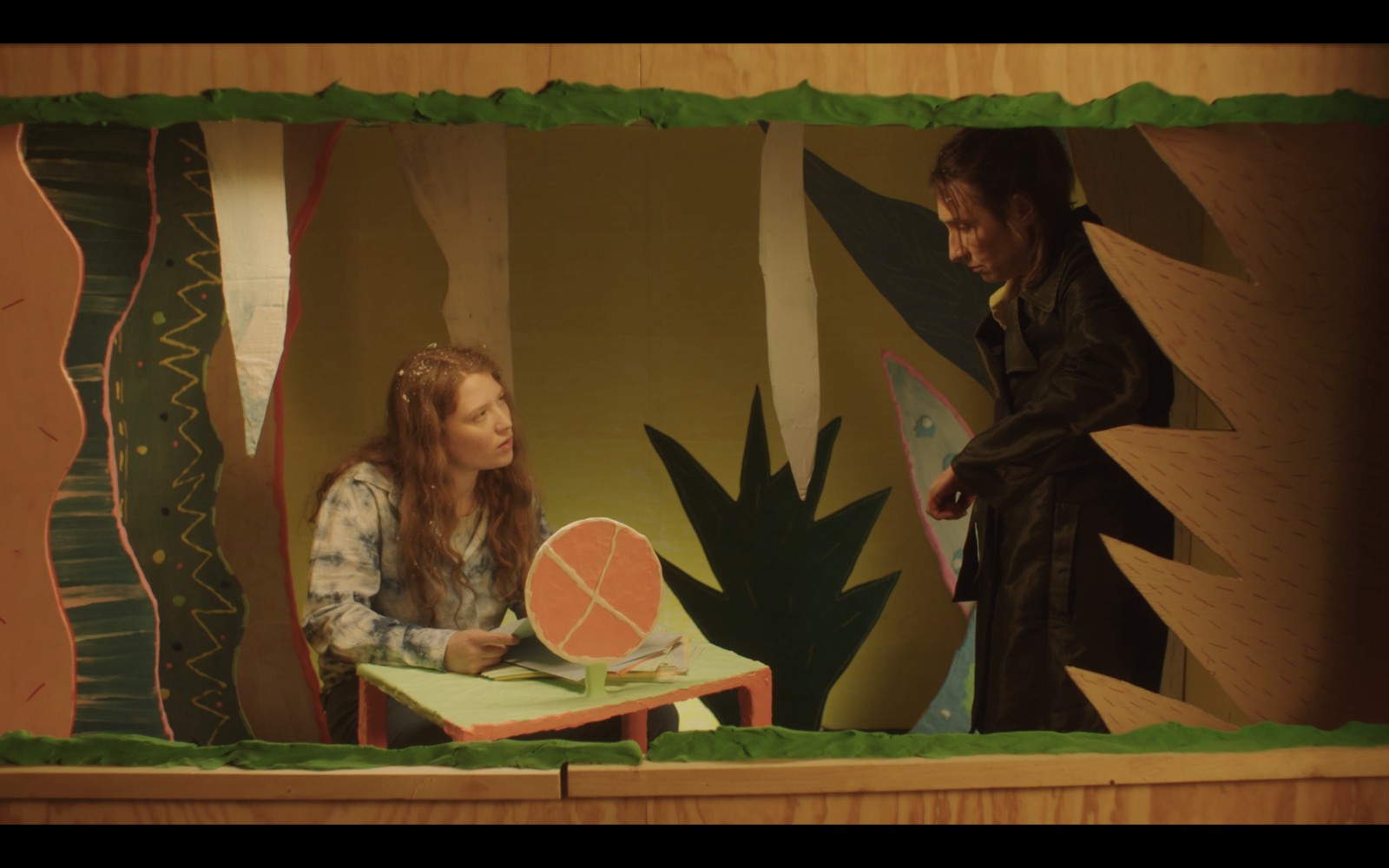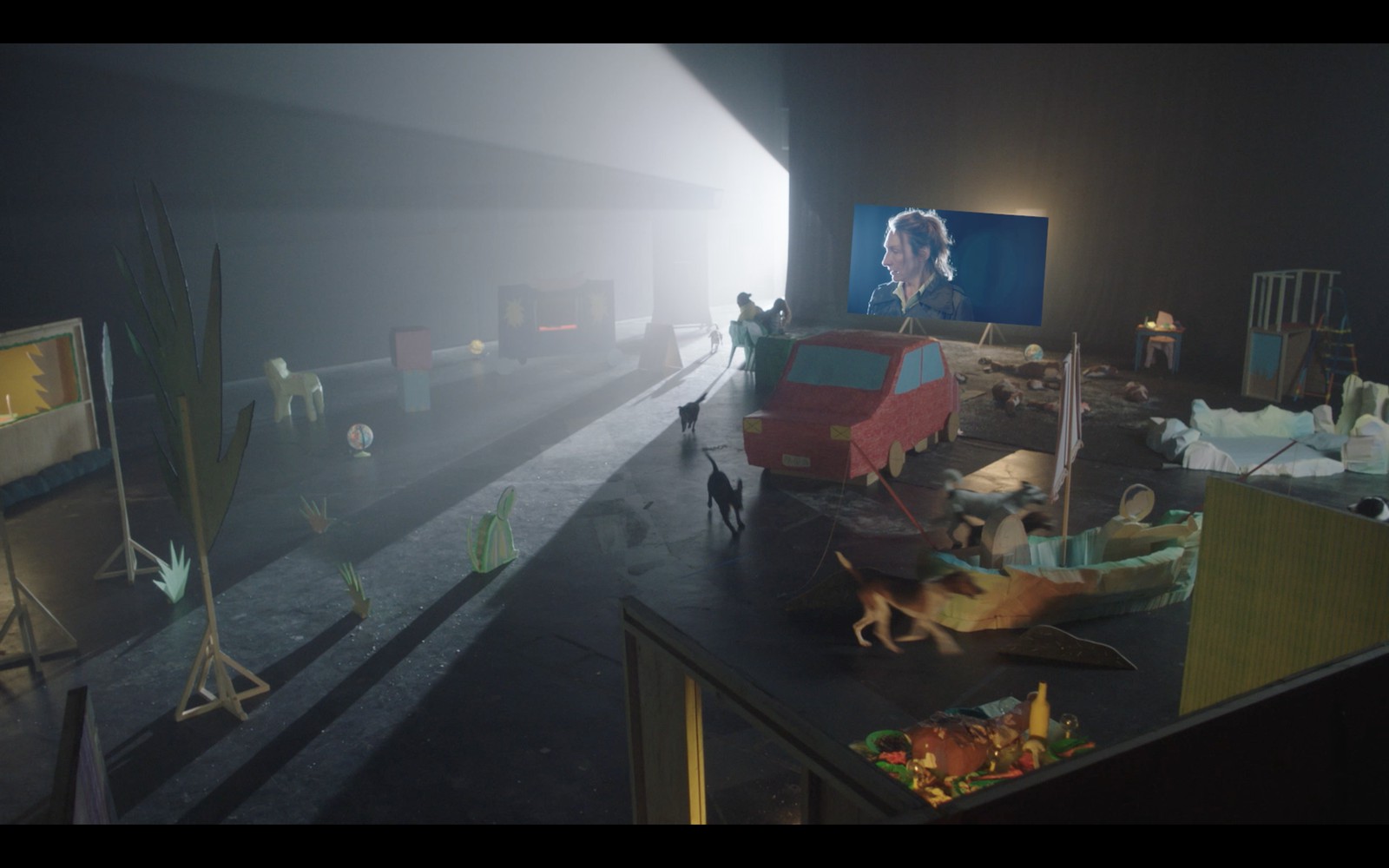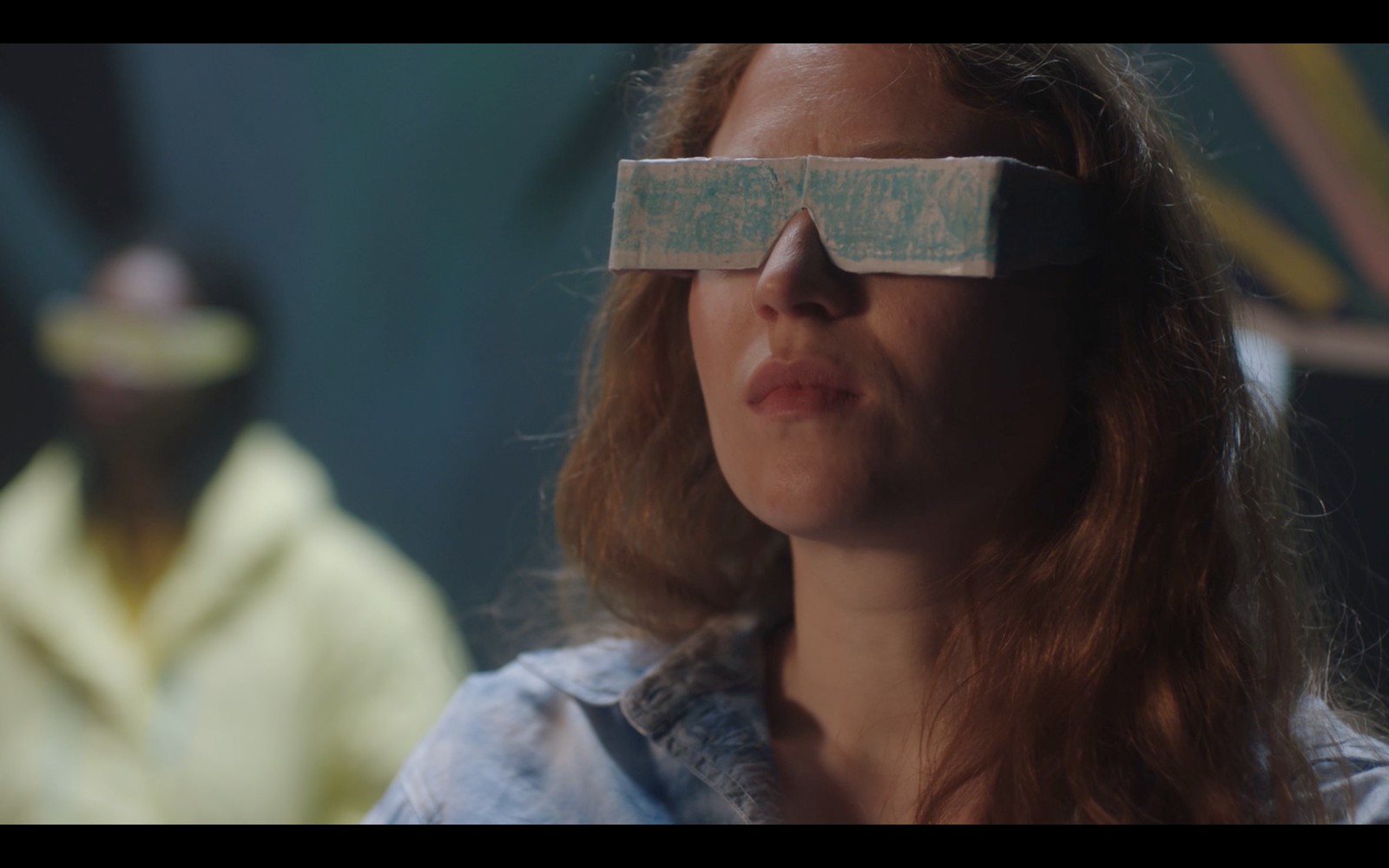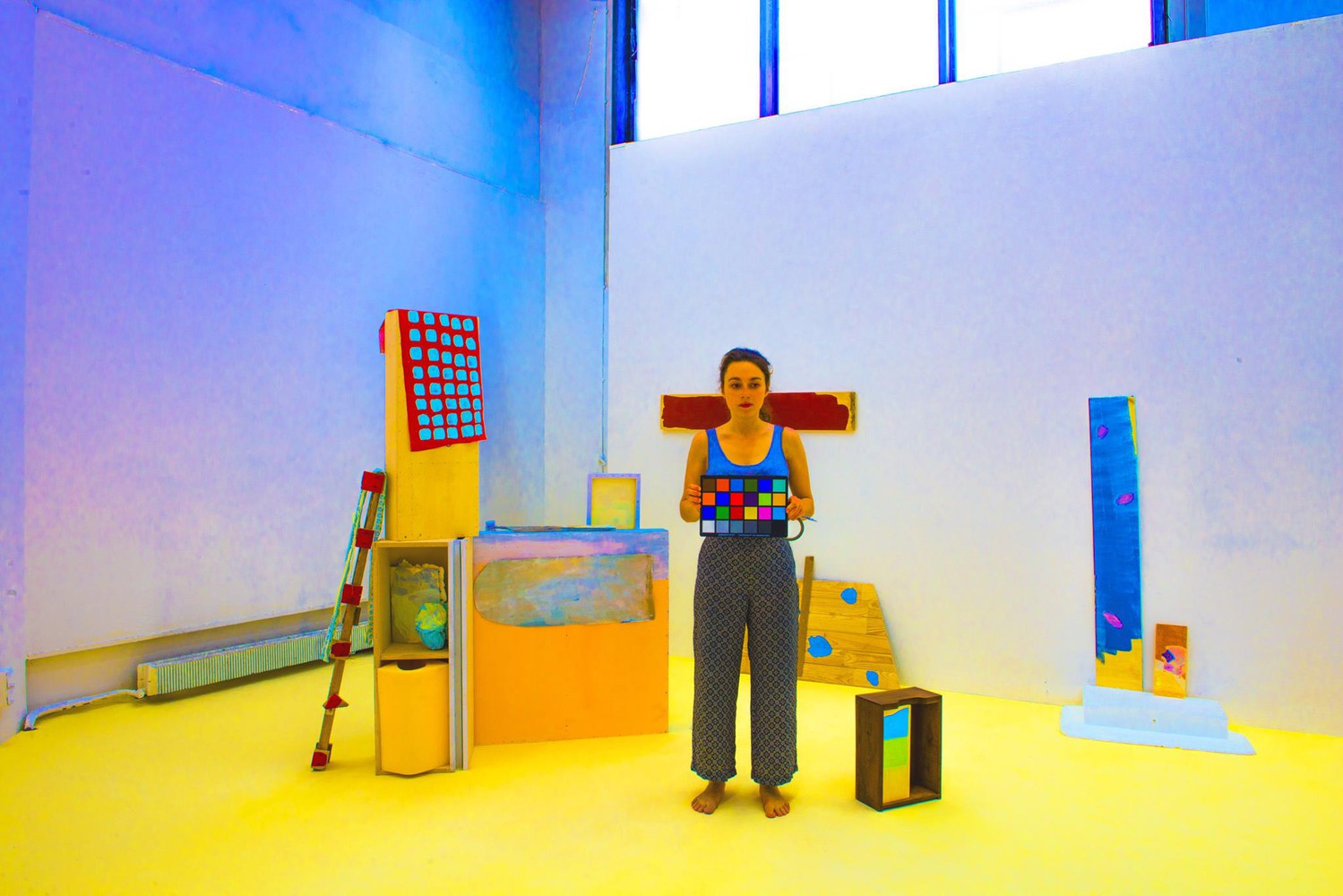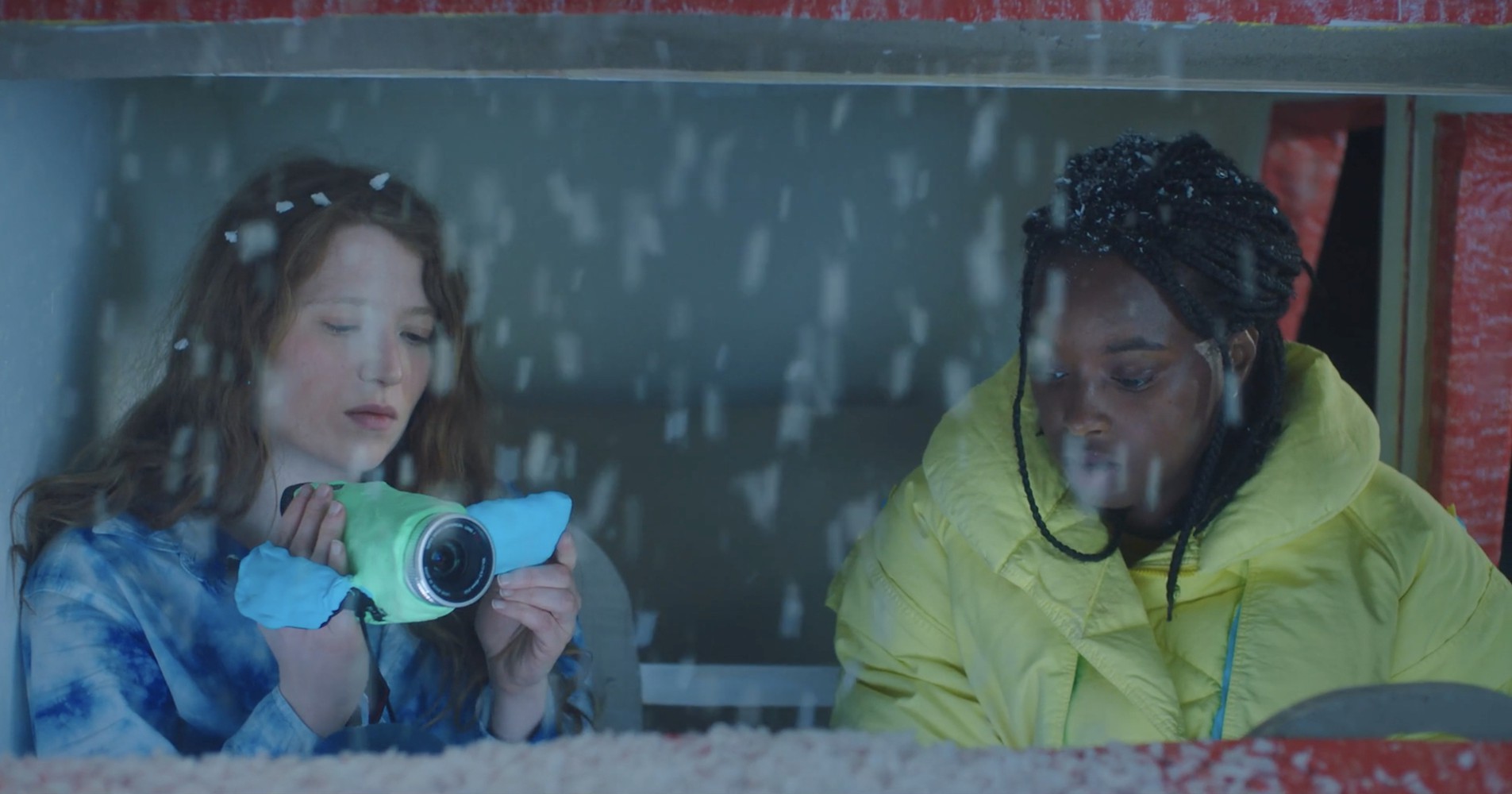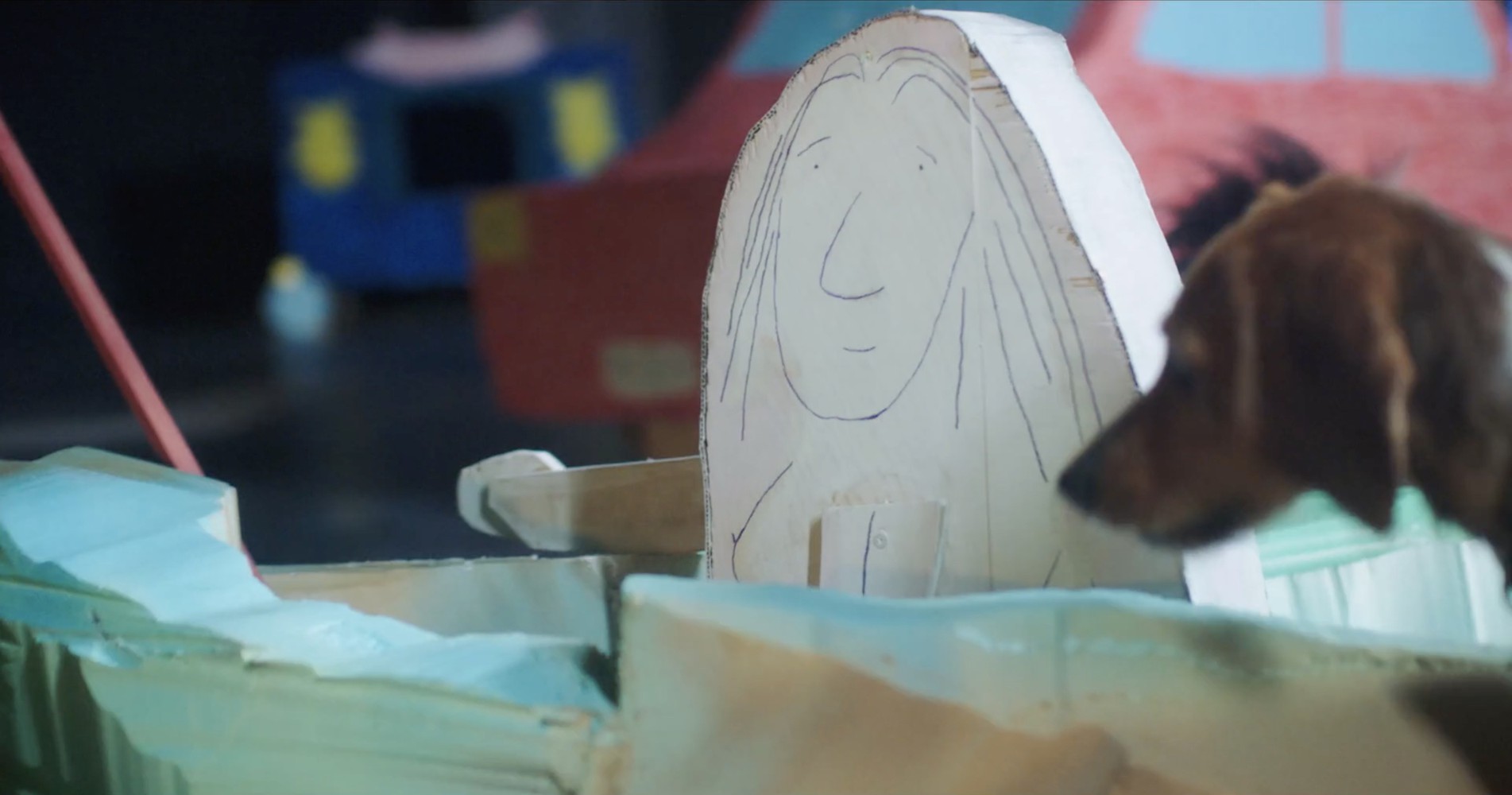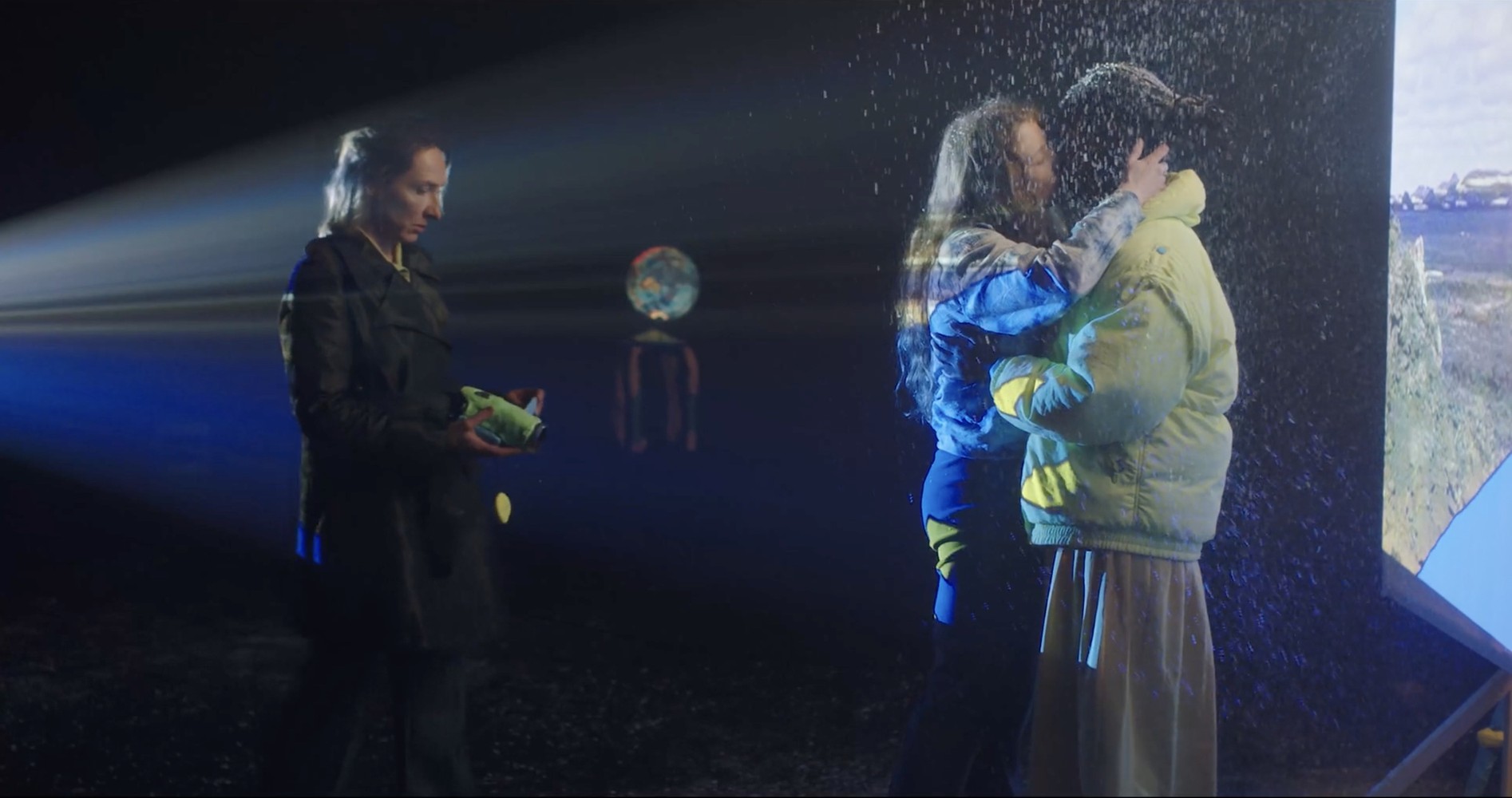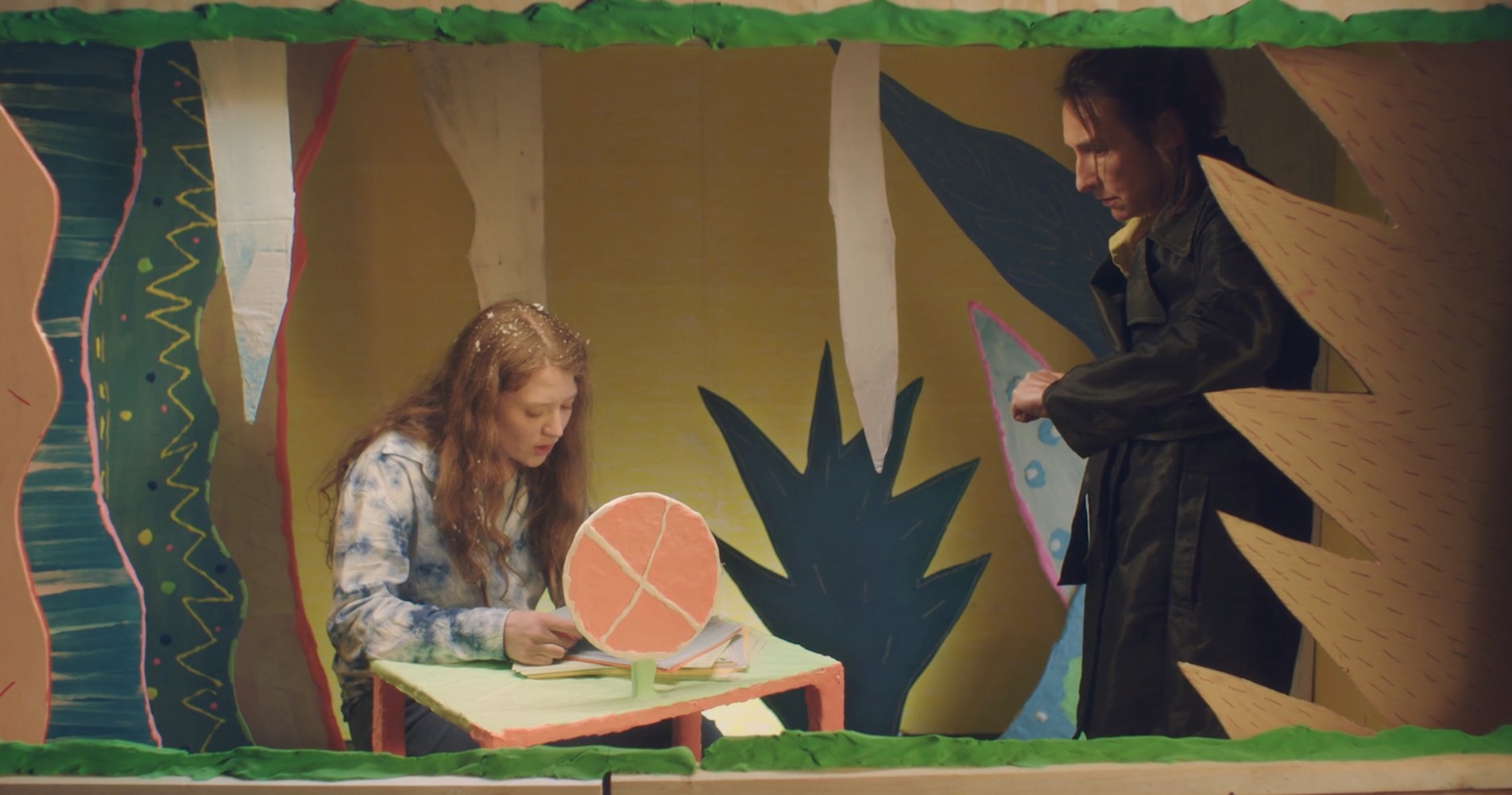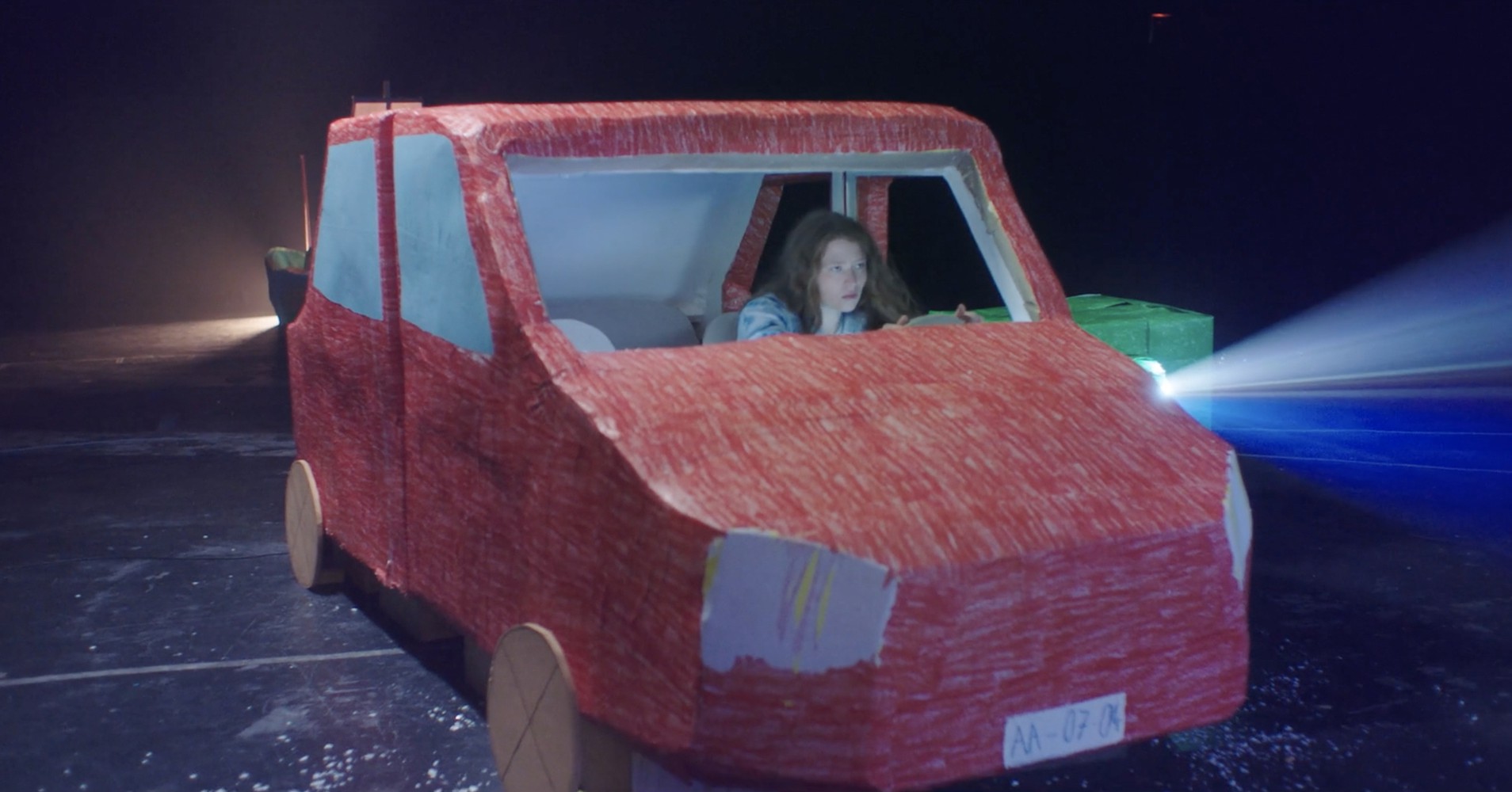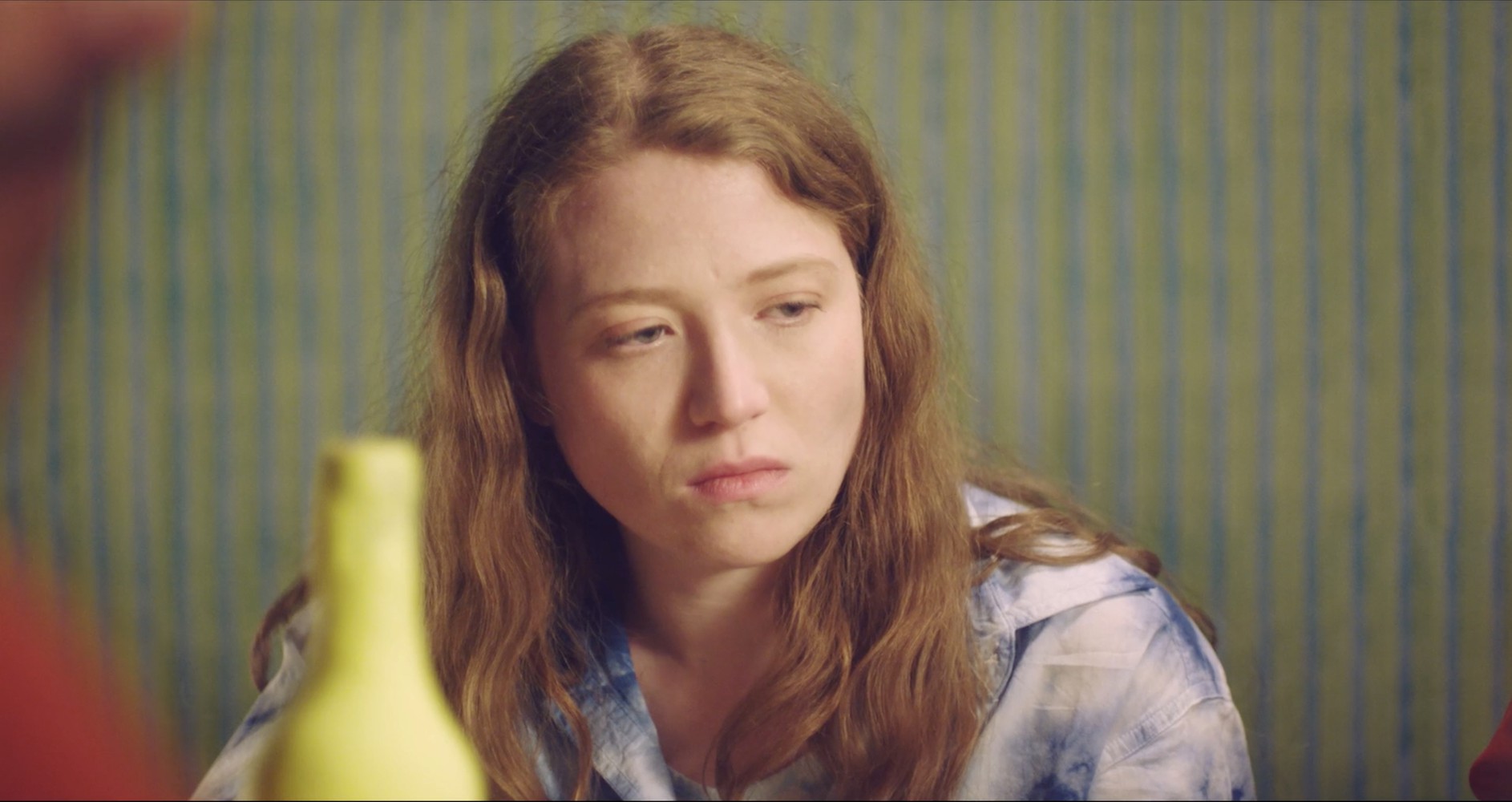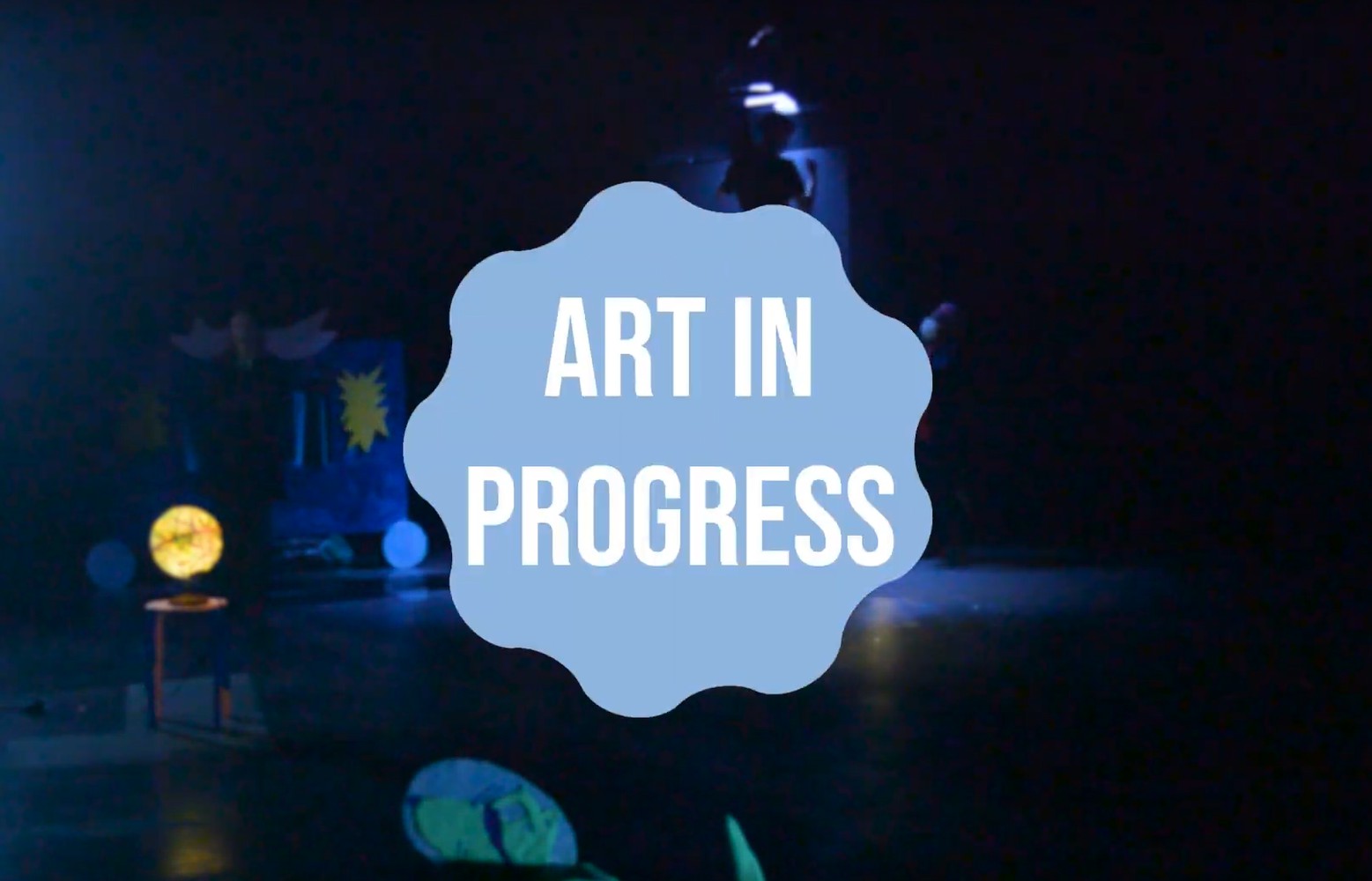Isolée dans un hangar, Lola rejoue ses souvenirs. Des décors s’éclairent, des personnages apparaissent, Lola navigue d’une scène à l’autre.
Juliette Dominati travaille sur les souvenirs, ce qui reste, ce qui échappe, des détails, des presque rien. À la fois peintre et metteur-en-scène, elle s’intéresse à la construction d’environnements, complets, autonomes, enveloppants. Ses installations ressemblent à des collages en volume, faits d’objets trouvés et peints. Son travail est fait d’astuces, de matériaux souvent pauvres, de rebuts, de trouvailles. Elle collectionne des histoires, des images, des matériaux abandonnés, du bois, du tissu, du mobilier, enregistre des récits, archive des moments, qu’elle colle, scotche, rejoue. Ces fragments sont assemblés avec délicatesse, et équilibre troublant, tenant à peine, toujours sur le point de s’écrouler. Pourtant ils « tiennent » des espaces, construisent des mondes qui semblent attendre que spectateurs et personnages entrent, s’approchent, s’installent. Ces mises-en-scènes cultivent une aura intime, une quiétude mystérieuse, et un « mal-aise » propre aux rêves. S’en approcher c’est faire l’expérience d’un effondrement, de palimpsestes, de souvenirs fracturés, à la fois confus et joyeux.
Émile et Jérémy Amzallag, AEI ; Didier Diaz, Transpalux ; Jean-François Lemaire, Pyrofolies.
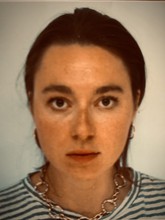
Née à Paris en 1990, Juliette Dominati est réalisatrice et plasticienne. Son travail est régulièrement exposé en France et à l’étranger (Argentine, États-Unis, Chine, Islande, Royaume-Uni) et sera prochainement présenté au Salon de Montrouge, puis à Londres pour sa prochaine exposition personnelle.
CursusEXPOSITIONS PERSONNELLES
2019 « The Stolen Stone Project » with Toti Ripper, Seyðisfjörður, ICE
All I want is more more more, PADA Studios, Lisbonne, PT
2018 Catastrophe!, Château de Sacy, Sacy-le-Petit, FR
2017 La chambre d'à côté, Galerie Duboys, Paris 20e, FR
EXPOSITIONS - RESIDENCES
2020 65ème Salon de Montrouge, Montrouge, FR
2019 Novembre à Vitry, Galerie Jean Collet, Vitry-sur-Seine, FR
EXH 01, Floorr Magazine online exhibition, UK
Rude Assembly Part 4, Oxford St, Sydney, AU
« The Stolen Stone Project », Artagon Live, Cité Internationale des Arts, FR
Carry on combines, Galerie MR80, Paris 4e, FR
Heima, Art Residency Program, Seyðisfjörður, ICE
PADA Studios Residency, Awarded 2019, Lisbon, PT
Micro, AIR Gallery, The Warehouse, Altrincham, UK
Radical Residency III, Unit 1 Gallery, Awarded 2019, London, UK
2018 Salad Day, YoungSpace Winter Show, https://yngspc.com, USA
Résidence d’artistes de Sacy, Château de Sacy, Sacy-le-Petit, FR
The London List, The Curators, by Benjamin Weaver, New York City, USA
Bibelot, Summer Show, Wendy Galerie, Paris 7e, FR
PLEAT Gallery, Exhibitionism, curator Bethanie Irons, Galerie en ligne, USA
El Mismo Perro, Bolivar Club, Buenos Aires, ARG
2017 Novembre à Vitry, Galerie Jean Collet, Vitry-sur-Seine, FR
YIA – Young International Art Fair #11, Le Carreau du Temple, Paris 3e, FR
Artagon III, Les Petites Serres, Paris 5e, FR
Houses ans Trees, Luren Gallery, Suzhou, Chine, CHN
2016 Exposition de groupe, Galerie Duboys, Paris 3e, FR
Artagon II, Passage de Retz, Paris 3e, FR
Mille Feuillets VI, Ygrec, Paris 13e, FR
2015 Tours de Babel changées en ponts, Galerie Chenaux, Paris 3e, FR
ECRITURE - MISE EN SCENE
2020 The Stolen Stone Project, , Seyðisfjörður, ICE
The Show doit continuer, film, Buenos Aires, ARG
2018 El mundo es un escenario, court-métrage, Buenos Aires, ARG
2017 Pot-pourri, ENSAPC, Cergy, France, FR
2016 Les Oiseaux, Festival, Les Traversées du Marais, Parcours Musical, FR
2015 En petits morceaux, Le Kiosque électronique, Théâtre des Amandiers, Nanterre, FR - Kogan Gallery, Paris 3e, FR- La Générale, Paris 11e, FR
Les Enchaînés, Le Salon H, Paris 6e, FR
COMMISSARIAT
2018 Insignificante y Perecido, Club Bolivar, San Telmo, Buenos Aires, ARG
2016 Placards, ENSAPC, Cergy, FR
PUBLICATIONS
2019 Floorr Magazine, interview par Nathalie Gonzalez, UK
FOA, interview parJustin Archer, USA
2018 Pince-mi et peins-moi par Joris Thomas, Château de Sacy, FR
FORMATION
2016-présent Licence philosophie, Sorbonne Paris IV, Paris, FR
2012-2017 DNEP, Ecole Nationale Supérieure d'Arts Paris-Cergy, Cergy, FR
Production : Le Fresnoy, Studio national des arts contemporains
Il arrive que, quelles que soient les atteintes, un corps ne meurt jamais. Il répond à ce qui le blesse, le met en danger, par un surcroît de présence. Sa disparition ne le rend-elle pas, au contraire, plus vivant ? Dès lors qu’il n’est plus, nous ne cessons de le chercher. le corps bouge avant et après la mort. Il n’y a pas de corps sans cela et de cela, le rêve nous instruit. Plus il est menacé d’oubli ou de destruction, plus nous puisons, dans les forces durêve, un élan qui le métamorphose et le rétablit. Dans la période que nous vivons, où le corps est sur la sellette, où nous est annoncé son évitement, ses évanouissements, sa dématérialisation, le rêve et l’utopie ne cessent de nous rappeler qu’il est toujours sur scène et pour longtemps...
Sur scène ou plutôt sur une des scènes multiples où il passe de l’une à l’autre. Jamais immobile, appelant le mouvement, la danse comme une respiration relançant les battements du cœur.
Par cette impulsion, il s’impose au centre, mais étrangement cette course, par sa vitesse, l’efface en le manifestant, par sa seule lumière qui nous éblouit. Par cette situation, le corps doute de lui-même. Il apparaît, il se dessine dans l’espace, mais l’intensité des lueurs n’est pas son alliée.
Elle le met en question. Il lutte contre une ombre qui le menace et dans laquelle il ne se reconnaît pas. S’il s’identifie d’abord aux lignes qui le cernent, qui lui permettent d’exister, de dire « je », le monde, joueur des multitudes lumineuses, le trouble et le défait. S’il est celui qui vient, il est aussi celui qui fuit. D’abord tache sur la terre, il se liquéfie dans une dilatation ou s’évapore dans une expansion dont nous perdons les confins. notre corps se disperse, se dissémine, et nous serions naïfs de croire en ses définitions physiques ou lexicales. Un temps, il est une évidence, mais celle-ci laisse place à l’inconnu où le salut se trouve dans l’occultation des apparences. Il se réfugie en un « noir » qui envahit l’espace et le recouvre, ayant pour vêtement les ténèbres de la nuit jusqu’à ce que l’éclairement, nécessaire à toute vie, relance la quête d’un être insaisissable, à travers l’image qui renaît.
À ce sujet, Junichiro tanizaki nous pose cette question : « avez-vous jamais, vous qui me lisez, vu la couleur des ténèbres à la lueur d’une flamme ? Elles sont faites d’une autre matière que celle des ténèbres de la nuit sur une route et, si je puis risquer une comparaison, elles paraissent faites de corpuscules comme d’une cendre ténue, dont chaque parcelle resplendirait de toutes les couleurs de l’arc-en-ciel. »au contact des œuvres de Panorama 23, j’éprouve cette sensation d’un territoire composite de cendres retournées par l’art en une suite de couleurs, réfractées dans l’eau et la lumière.
Répondre au délitement du monde par la danse, l’explosion bigarrée, traverser et spéculer avec ce qui l’éclaire ou l’efface, du noir au blanc, n’est pas une affaire de solitude. Éprouver la variabilité de ce va-et-vient, de cette métaphore, implique l’altérité, réclame l’autre qui invite au changement, à la fusion de substances différentes.
Cet autre est présent de façon insistante dans ce Panorama 23, il est la source et le flux du courant qui lie les œuvres. S’avancer par les chemins de l’exposition, c’est plonger dans un univers dont le principe est le croisement, le mélange, l’abouchement, comme il en est dans les mouvements de la mer, dans ses fonds marins. les créateurs réunis ici questionnent le corps et le langage, ils m’évoquent l’introduction de Moby Dick où Herman Melville définit son héros comme un nageur debibliothèque. oui, il s’agit bien de plongeurs qui nous emportent dans des flux qui sont la nature du monde où les corps se baignent, jusqu’à devenir le flux lui-même, cherchant à se fondre avec le corps de l’autre. Ils rêvent d’un corps possible où le morcellement, la coupure, la division sont effacés par les ressacs, les reflets d’une vague, insufflant le rythme au monde.Ce rythme engendre des suites infinies de glissements, projections, de fondus enchaînés où s’abandonne la différence des genres, où les règnes s’accouplent pour faire naître des corps en suspens, des sujets réels, travaillés sans cesse par le virtuel des mythologies ou des sciences-fictions. Ils sont des blocs de pierre tout autant que des fantômes, des nageurs, comme des noyés. Ils parlent vrai tout en chuchotant qu’ils ne sont qu’acteurs et artifices. Un de leurs états est semblable à celui des objets abandonnés, « aux restes », qui deviennent espaces sacrés, idéalisés, auréolés par des énigmes faisant de notre perception une quête initiatique.
Ici, les corps peuvent être soumis par la réification pour, dans l’instant suivant, la faire voler en éclat grâce à la puissance d’une pensée onirique. Ici les héros sont aussi les dormeurs, ou ceux pour qui le sommeil est une leçon. Dormir, aujourd’hui, est héroïque. Bien heureux ceux qui, pour connaître le monde, choisissent d’en être les dormeurs actifs.
« Mourir, dormir, rêver peut-être », écrit William Shakespeare au cœur du monologue d’Hamlet, qui par cette formule livre son secret. Cette trilogie, ces trois actes indissociables ne forment qu’un principe, un seul état, une seule pensée cherchant à se libérer et à s’offrir les chances d’imaginer un nouveau monde. Un monde où s’observe le travail d’abolition entre l’humain, le végétal et l’animal. Georges Bataille serait heureux de voir qu’il s’incarne dans la présence et les déambulations d’une panthère noire, vecteur de la connaissance grâce à une mystérieuse dépense d’énergie, une course vive. la transparence traverse cet univers, à la manière de Sebastiano Mazzoni, de Francis Picabia ou de François rouan. le végétal envahit l’architectural, puis l’animal, pour se fondre enfin en anatomies humaines irriguées par les humeurs, les liquides, l’eau qui composent nos larmes, rappelant notre nature fluide et volatile, entre mémoire et épanchement. Si une part de la vie est recelée dans nos os, comme l’imagine Edgar Poe ou l’artiste roy adzak, ces os ne pèsent pas, n’immobilisent pas car ils sécrètent les rêves, véritables acteurs des bouleversements qui nous déterminent. Sont-ils l’identité la plus fiable de notre corps, comme le proposent ces œuvres, dont l’une s’origine dans le thème philosophique et poétique du « change » d’Orlando de Virginia Woolf, alors que d’autres mettent en scène la « forme monstre » ou les corps électriques de lovecraft.
Quel est le réel de ces corps ? Celui d’un paradoxe où le plus physique, le plus matériel se manifeste par le virtuel le plus insaisissable. Celui des Ailes du désir de Wim Wenders ou celui de t.S. Eliot cherchant à formuler son désir d’incarner l’écriture par une parole improférée, une parole silencieuse. Un des artistes de Panorama 23 note : « J’aimerais pouvoir dire, tenter le silence dans la parole. » l’écriture peut être une maison qui quitte ses assises, se retourne en barque pour suivre son chemin vers la mer, par la rivière, vers les figures du rêve.
Une maison ? Une barque ? Singulières « anima » ? Je me souviens, aujourd’hui, d’une question posée à un danseur derviche, évoquant sans cesse l’âme : « Mais qu’est-ce que l’âme ? » Je me souviens mieux encore, en 2021, à tourcoing, de sa réponse : « Mais le corps bien entendu !
Olivier Kaeppelin
